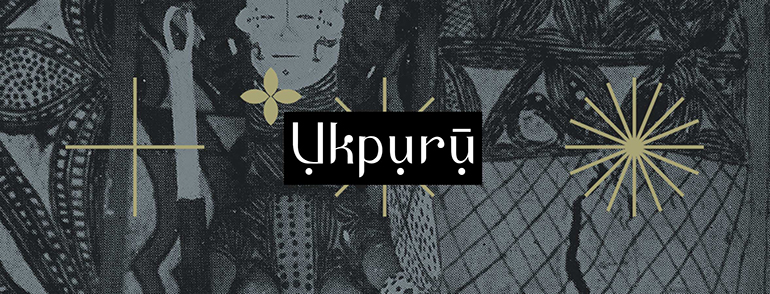[Igbo] Ohafia war dance The [Igbo] Ohafia war dance iri agha. Adult male carrying a headhunters trophy (oyaya) on his head. The trophy is a rectangular shaped wooden frame decorated with feathers, leopard fur, cloths and animal fur at either end. He is wearing a striped shirt, and holding a ?metal rod in one hand. Behind him is a crowd of people and a Building with corrugated iron roof.— Jones, G.I. 1932 - 1939 Location: Ohafia, Alaigbo | Date: 1930s | Credit: Jones
Monday, December 10, 2012
Igbo Ohafia war dance iri agha
Category:
Crowds,
Full Length Portraits,
Igbo,
Masquerades,
Ohafia
Friday, December 7, 2012
Wall paintings in Okwu village
Wall paintings in Okwu village painted by an Anang artist in the style of Ngwomo ghost houses.— Jones Location: Okwu, Alaigbo | Date: 1930s | Credit: Jones
Thursday, December 6, 2012
Rumuji Owu play
[Igbo] Rumuji Owu play with the character of Oterivinwe sitting on a chair. The masquerader is wearing a wooden, beautiful female, white face mask with two horns attached to the top. The neck is coiled and attached to the mask is a print cloth. The masqueradere is wearing white cotton trousers and seed anklets around the ankles. In the background are spectators and vegetation.Location: Rumuji, Alaigbo? | Date: 1930s | Credit: Jones
Category:
Igbo,
Masquerades,
Owu,
Portraits
Interior of Igbo Mbari house
Interior of Igbo Mbari house. Sculpture in foreground representing adult male riding animal, second adult male standing in front of animal.Location: ?Unknown?, Alaigbo | Date: ?Unknown? | Credit: Edward Chadwick
Wednesday, December 5, 2012
A Visit to Ogume in 1937
A Nwammuo [of the Ogume Ika-Igbo (now in Delta State, Nigeria] was a trophy used in a dance or play of the same name. It consisted of groups of little human figures arranged in tiers one above the other. The one I photographed [the photo attached] was two-tiered, with four figures in each tier, and surmounted by two birds, but Ufere was said to have carved Nwammuo with up to four tiers and sixteen figures. I gathered that the principal dancer would carry the trophy on his head and a paddle in his right hand, and that the others (who could be both men and women) would dance in a circle around him. [Nwammuo means ‘ghost-spirit child/offspring’ in Igbo]A Visit to Ogume in 1937, by G. I. Jones.
Location: Ogume, Ika, Alaigbo | Date: 1930s | Credit: Jones
Subscribe to:
Comments (Atom)
